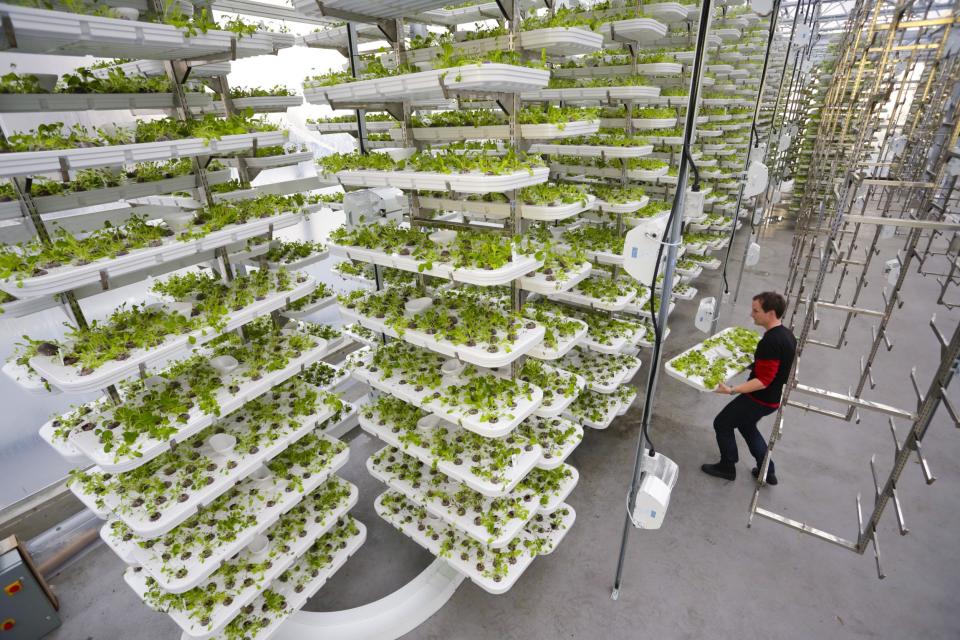To Feed Humankind, We Need the Farms of the Future Today
Right now—at this very moment—there are over 7 billion humans crawling on the Earth. That’s a lot of mouths to feed. To sustain them all, we’ve taken 40 percent of the planet’s total landmass and turned it into cornfields and almond orchards, cattle ranches and orange groves, all to churn out the cereals, produce and meat that feed humanity.
Unfortunately, that’s left us in a bit of a bind. The world population is expected to grow to 9.6 billion by 2050, and according to the Food and Agriculture Organization of the United Nations (FAO), if we want to avoid mass malnutrition, we’re going to have to up our food production by 70 percent by 2050. The problem is most of the land we can work for food is already being cultivated. The rest is atop mountains, covered by desert sands or in Antarctica. The only potential farmland left would require slashing and burning the world’s remaining rain forests. That means we’re going to have to make some large-scale changes to how we farm.
It’s not impossible. In fact, it’s been done once before in living memory. Few people have heard of Norman Borlaug, but if you’re seeking a revolution in farming, he’s probably the first person you’ll want to look up. In the mid-1940s, wanting to increase wheat yields in the highlands of south-central Mexico, Borlaug bred several high-yield, disease-resistant strains of semi-dwarf wheat well-suited to Mexico’s mountains. Farmers who planted Borlaug’s wheat saw yields increase immediately; these gains were especially evident when the crops were planted in soil treated with nitrogen fertilizer. The method caught on quickly, and by 1963 95 percent of Mexico’s wheat crop was Borlaug’s dwarf wheat. Between 1944 (the year Borlaug arrived in Mexico) and 1963, Mexico’s wheat yields sextupled.

Then Borlaug went to South Asia.
In the mid-1960s, South Asia was starving, mostly because the region’s food production couldn’t keep up with its population growth. Believing he could help, Borlaug began exporting his high-yield wheat to the subcontinent. He eventually moved there, spending 16 years supervising the first few plantings and harvests. The results were tremendous: After just five years, the wheat yields in India and Pakistan had nearly doubled. By 1974, both countries were self-sufficient in cereal production, and Borlaug’s methods were spreading rapidly to the rest of South Asia and Southeast Asia. Famine had been averted.
But humanity can’t keep coasting on Borlaug’s green revolution—land is now at a premium in a way it wasn’t during Borlaug’s era. Time has also shown that the revolution was far from perfect; in his quest to feed the world, Borlaug encouraged monocropping (growing a single crop year after year on the same land, without diversification or rotation) and heavy use of nitrogen fertilizer made from petroleum, both of which can produce massive short-term gains in crop yields but in the long run make the land less fertile. In addition, Borlaug’s focus on rice, corn and wheat as tools to prevent famine led him to ignore several crops that we now know are even more nutritious and produce even more calories per acre than those three: potatoes and sweet potatoes, for instance.
Related: Aquaponics Revives an Ancient Farming Technique to Feed the World
For better or worse, we eat the world Borlaug built. But now we need to make some changes to that world, so it can produce 70 percent more calories on the same amount of land. And we need to start with fruits and vegetables.
The Fruit Skyscraper
The Tabernas desert, in southern Spain, is the driest place in Europe. In the 1960s, it was known primarily as a place filmmakers went when they wanted to film spaghetti Westerns; The Good, the Bad & the Ugly and Once Upon a Time in the West were both shot there. But then the land began to blossom, and today the arid desert is where more than half of Europe’s fresh vegetables and fruits are grown.
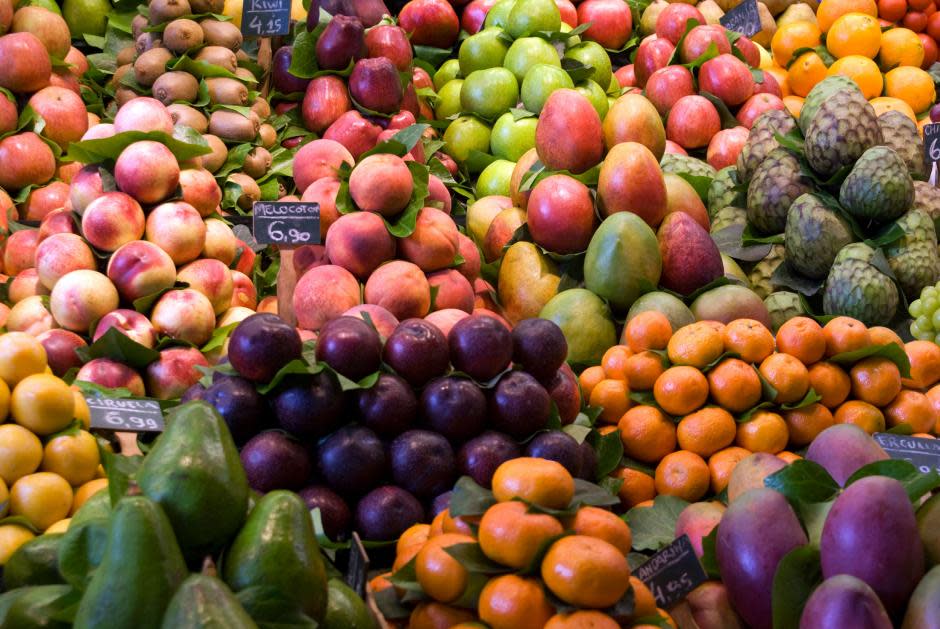
The credit goes to greenhouses. The first few were built there in 1963, courtesy of a land distribution project spearheaded by Spain's Instituto Nacional de Colonización. Fruits and vegetables from those greenhouses, where the environment could be controlled and beautiful produce could be grown, consistently soon outsold comparable crops grown in open fields, bringing in a windfall for the previously impoverished citizens of Almeria, the Spanish province that contains the Tabernas. That money was reinvested, the greenhouses were expanded—with inexpensive plastic sheeting replacing glass as the material of choice for the majority of the controlled environments—and today greenhouses cover 50,000 acres in the Tabernas desert, adding $1.5 billion annually to the economy of Almeria.
Tabernas’s massive greenhouse clusters—visible to the naked eye in low-Earth orbit—have been touted as an economic miracle, but they are more than that: They are proof of concept. Right now, only wealthy-but-land-strapped Europe uses greenhouses to grow a significant fraction of its fresh produce. But with the rest of the world quickly getting wealthier and more land-strapped, the Tabernas model may take off.
That’s because from an environmental and land-use perspective, controlled-environment farming is a great idea. Fruits and vegetables grown indoors tend to have far greater yields per area than comparable produce grown outside. Put a roof and walls around produce, and most problems caused by weeds, pests and inclement weather vanish. Add technology like hydroponics—growing plants so the roots sit in a customized nutrient slurry instead of in plain old dirt—to the equation, and yields increase even more. Better yet, build a hydroponic rig that is modular, rotates and stacks—which means you can have several “stories” of produce growing atop the same ground (assuming the stacks all get sufficient light), where an outdoor farmer would be stuck with only one.
This “stacking” of plants can be taken to extremes. In 2005, Dickson Despommier, professor emeritus of public health at Columbia University, put up a website plugging “vertical farms,” a concept he’d invented with his students four years prior. In some ways, it’s as simple as it sounds: “A vertical farm is a multiple-story high-tech greenhouse,” says Despommier. But there are a lot of challenges involved, from getting sufficient light to all the plants to keeping pests and diseases out of the crops to make sure they grow properly. “There’s a lot of technical stuff and engineering that needs to be overcome, and that’s why it wasn’t done until it became necessary to do it.”
Vertical Farms Across the World
With arable land becoming more and more sparse, and global populations continuing to rise, the only direction to grow our farms is up.
In 2011, a calamity in Japan made it necessary. The tidal wave that caused the Fukushima disaster wiped out most of the farmland near Sendai, a coastal area in the northern half of Honshu, the largest island of Japan. The Japanese government decided to jump-start a vertical farm building boom there in an effort to replace the lost land. Four years later, Japan boasts hundreds of vertical farms, greenhouses stacked high into multistory skyscrapers, where plants rotate daily to catch sunlight. Instead of porting dirt into the buildings, the plants grow with roots exposed, soaking in nutrients from enriched water or mist.
Aeroponics, a companion technology to hydroponics, has taken off in Japan and is helping high-tech greenhouses produce remarkable yields remarkably quickly: Unlike hydroponic systems, where plants dip their roots in nutrient slurry, aeroponic systems spray the plants’ deliberately exposed roots with a nutrient-laden mist. “The root systems grow much longer because they have to increase their surface area to absorb the same amount of nutrients,” explains Despommier. That, in turn, makes the plants grow much faster.
Related: The Dirty Truth About ‘Organic’ Produce
Singapore, Sweden, South Korea, Canada, China and the Netherlands all now boast skyscraper farms similar in concept to Japan’s. In the U.S., such farms have risen in Chicago, while Newark, New Jersey, and Jackson, Wyoming, both have contracts with private controlled-environment vendors to build their own.
But with vertical farms, at least as they’re currently conceived, light remains a problem; the towers need to be narrow enough to let sunlight penetrate all the way through, or else builders must figure out a way to rotate the growing plants to make sure they all catch a healthy complement of sunlight. Or, perhaps, there’s a simpler solution: Replace that sunlight with artificial sources of light energy, like light-emitting diodes.
In the U.K. and the Netherlands, in Boston and in Bryan, Texas, it’s been done. “Pinkhouses,” as they’re sometimes called, are lit blue and red: Those are the spectrums of visible light best absorbed by plants. By using these colors alone, pinkhouses generate serious efficiency: In the wild, plants use at most 8 percent of the light they absorb, while in pinkhouses, the plants can use as much as 15 percent. In addition, because everything happens entirely indoors, the lights, temperature and humidity can be controlled to an extent not possible even in the most high-tech, sun-dependent vertical farms and greenhouses.
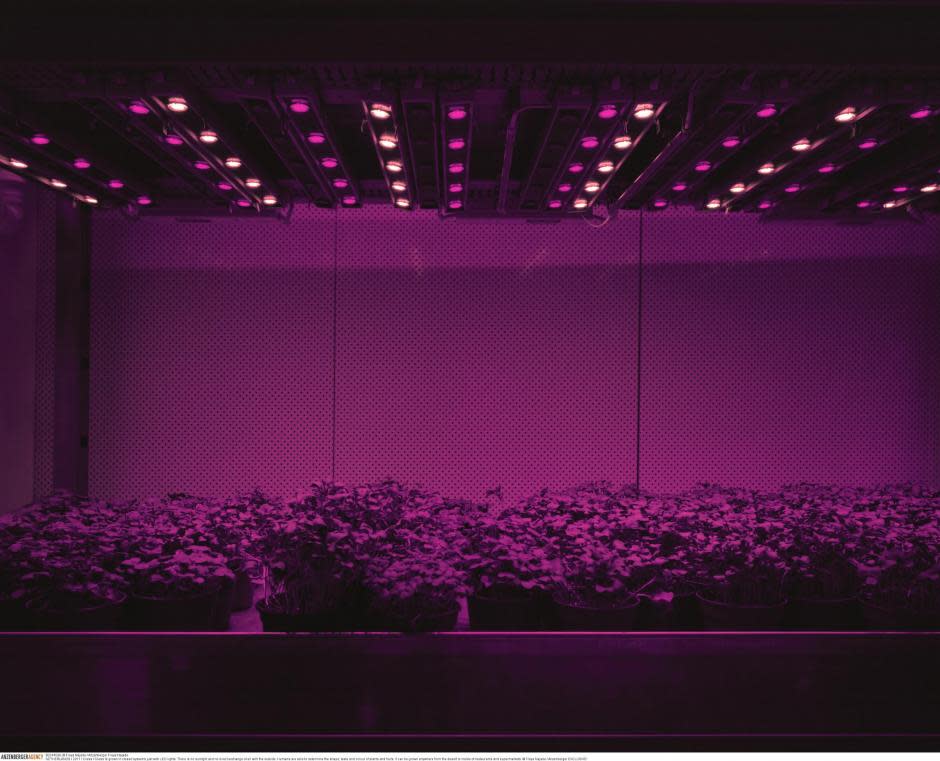
As a result, the plants grown in these pinkhouses grow 20 percent faster than their outdoor cousins, and need 91 percent less water, negligible fertilizer and no treatment with herbicides or pesticides. Currently, the LEDs keep the upfront costs of constructing pinkhouse very high, but LED prices are projected to drop by half in the next five years. Given that, perhaps we ought to be preparing for a future where the majority of our produce is grown industrially in LED-lined skyscrapers made of steel and poured concrete.
Sweet Potato Relief
Chew on this stat: In the U.S., as much as 40 percent of produce grown is never sold or eaten. The reason? It’s too ugly.
Consumers won’t buy imperfect fruit and vegetables, and grocery stores refuse to stock them. The demand for “pretty” produce means fruit and vegetable farmers need to make up for the cost of all that food they can’t sell. As a result, the produce currently sold in groceries is just what can make for fat profit margins.
That’s also why controlled environments, from pinkhouses in Boston to plastic-sheeted greenhouses in Almeria, are used overwhelmingly to grow fresh produce: Farmers who work in controlled environments can put out consistently pretty pieces of produce. They have a huge advantage in the current fruit and vegetable market, which values the look of the crop as much as anything. Moreover, with produce, freshness fetches a premium; the shorter a distance a piece of produce has to travel before it reaches your plate, the tastier it’ll be and the more you’ll pay for it. And controlled environments allow farmers to grow their produce right next door to where it’s sold. That’s why, even in the land-rich U.S., says Chieri Kubota, a professor at the University of Arizona’s School of Plant Sciences, 40 percent of tomatoes today sold fresh in stores are grown in greenhouses.
But controlled-environment farming is far less profitable for growers of staples. Rice, corn and wheat—the cereal grains that provide the world with about 50 percent of its calories—are all dirt-cheap, more or less regardless of appearance. The margins on those crops are thin, so any additional investment in innovation and production methods comes at an impossibly steep price. Staple farmers can see their profits only by growing huge amounts of their crops on enormous swaths of land; economically, it doesn’t make sense for them to try to replicate that profit model in greenhouses, so controlled-environment farming is unlikely to supplant the open field when it comes to our most important crops.
Increasing the yield of staple crops to the point where we can feed 9.6 billion people likely won’t involve anything as glamorous as greenhouse clusters seen from space; it might be as simple as making the whole farming world more modern. “A lot of poor farmers in underdeveloped countries are still farming as though it’s 10,000 B.C.,” says Dan Glickman, former U.S. secretary of agriculture, now consulting with several nonprofits that hope to solve world hunger. “There’s no crop rotation, no irrigation; people are still using animals for plows. Just exporting modern farming practices globally will do a lot to feed a lot more people.”
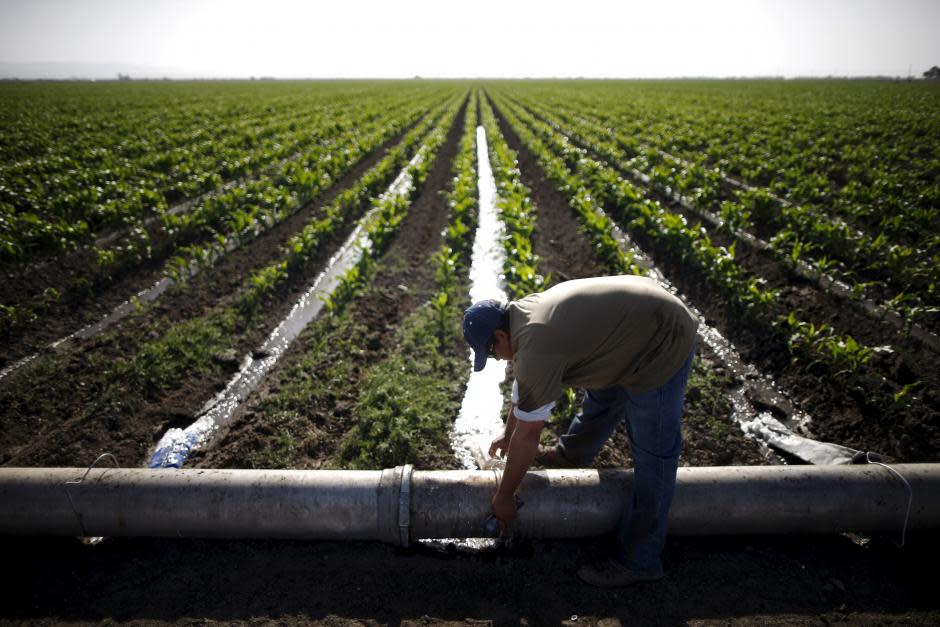
Universal adoption of crop rotation in particular could be a game-changer. Without any intervention, fields planted with staple crops over and over again eventually grow “exhausted”—the plants eat up all the nitrogen in the soil, rendering it sterile. The most common solutions are to either introduce more nitrogen via fertilizer or to lay the field fallow until the soil recovers and crops can be grown again. Both options have significant costs, either monetarily (fertilizer is costly, particularly for small farmers in rural areas) or in calories produced (fallow fields are aren’t producing). But there’s also a fairly straightforward alternative: Instead of leaving fields fallow while they recover, it’s possible to plant certain crops—largely legumes—that will reintroduce nitrogen into the soil. In other words, by alternating every corn harvest with a harvest of peas or beans, a field need never lie fallow.
Related: Fixing Farming Without Breaking Food
Moreover, diversifying crops can add much-needed nutrients to most local diets. In 2008, Joel Bourne, agronomist, journalist and author of The End of Plenty, went to Malawi to assist aid workers in introducing crop rotation to local farmers. “People there now are so dependent on maize,” Bourne says. “They eat this white corn porridge that gives them the bulk of their calories, but it’s very low in other types of nutrients, so getting farmers to plant legumes, pigeon peas and ground nuts helps us boost nutrition in the area.”
Another, more blue-sky option is an overhaul of our global dietary makeup. Compared with other potential staples, wheat, rice and corn don’t produce very many calories per acre; corn yields 7.5 million calories, rice 7.4 million and wheat a mere 3 million. Sweet potatoes, meanwhile, can produce 10.3 million calories per acre, grow in poor soil and tolerate irregular rainfall. Potatoes (which, despite the name, aren’t related to sweet potatoes) produce 9.2 million calories per acre, grow in any well-drained soil and can tolerate frost. Both have bona fides as staple crops—the humble potato, for example, got Europe through the Industrial Revolution’s population boom, while for a long time the sweet potato served as the primary staple for both native Hawaiians and the Maori people of what is now New Zealand—but were sidelined by Borlaug and his disciples during the green revolution in favor of wheat, rice and corn.
Given the calories-to-acres ratio we’re going to have to get to if we want to feed future generations, potatoes and sweet potatoes are due for a renaissance. Indeed, in places where arable land is scarce, it’s already begun: The Kenyan government, working with the agricultural nongovernmental organization One Acre Fund, is encouraging farmers to plant sweet potatoes instead of maize, while the Chinese government has asked its citizens to make potatoes part of the national diet. Even the United Nations has begun putting its weight behind tubers; in 2008, the potato was declared the “food of the future,” and today the U.N. runs a fund specifically to support potato farmers around the world.
Techie Tractors
Until that tuber revival goes global, efficiency will be the main game. Almost half of the world’s supply of cereals (wheat, rice and corn, as well as less popular grains like sorghum and barley) is grown in the U.S., India and China. In all three nations, data-driven farming is on the rise, along with new fields of study and new careers for those willing to crunch a lot of numbers.

K.C. Ting, head of the University of Illinois at Urbana-Champaign’s Department of Agricultural and Biological Engineering, works with open-field farmers (those who plant out under the big blue sky) to increase yield while keeping the costs of things like water and fertilizer flat—and even sometimes decreasing expenses. Ting and his fellows map fields, figuring out which locations produce the highest yields and then gathering key data about those spots: everything from soil pH and water levels to mineral content in the ground. With this information, Ting and other “AB engineers” can help farmers plan where to till and where to spray water, herbicides, pesticides and fertilizer. On larger farms, they can automate some or all of these processes (tilling, spraying, fertilizing) so they’re done far more efficiently than they could be with human hands. Automating farm equipment also helps the engineers collect more data—and year after year, as the data’s collected, the farm gets more efficient.
Related: Face Off: Organic vs. Conventional
Brian Scott, a farmer and occasional farm-life blogger residing in Indiana, grows “a little over 2,000 acres” of corn, popcorn, wheat and soybeans. (That’s fairly large; the midpoint acreage of farms in the U.S. is 1,105.) He ticks off the high-tech tools he uses on his farm: tractors equipped with GPS and autosteer that till straight every time (because “in a 10-to-12-hour day, it’s hard for a human hand or brain to continually till a perfectly straight line”), a planter that “knows where it is and knows where it’s been” so it never replants the same patch of ground, a fertilizer tube that does the same, pH tests for his fields, yield maps and yield histories of his soybeans and corn. He doesn’t even have some of the hottest stuff out there (crop sensors, irrigation via smartphone), but Scott says the tech toys he does use have helped him increase yield while saving substantial sums of money.
But when asked if the yields of technophile American farmers will help alleviate global hunger in a world of 9 billion plus, Scott goes quiet. His answer, when it comes, is thoughtful. “People sometimes forget that if we grow 300 bushels of corn per acre”—almost twice last year’s record-breaking average—“that’s great, but what’s the price going to be?”
Scott fears that if overproduction of corn drops the price of corn too far, fewer farmers will find it worth their while to produce corn in bulk—which will lead to less corn being grown worldwide. As a result, he says “those crops [won’t] necessarily get to the people in poor countries.” Financial incentives are key; “a lot of farmers have told me recently that the concept of feeding the world doesn’t resonate with them so much anymore,” says Scott.
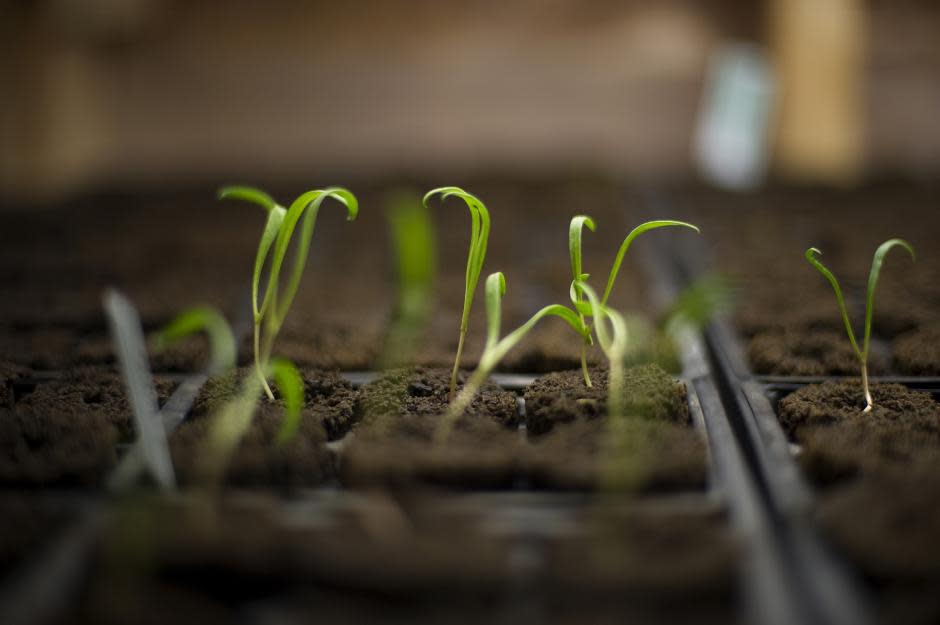
Meet Lab Meat
The complex interplay between consumer demand, crop yields and grower incentives plays out prominently in what is probably today’s hottest Big Ag topic: genetically modified organisms. A lot of Scott’s crops are actually GMOs; much of his corn is Bt corn (poisonous to certain insects), and all of his soybeans are Roundup Ready (herbicide resistant)—it helps him keep his yields high. But recent changes in consumer demand for non-GMO products has pushed him to keep some of his crops unmodified. “Last year, I think almost all our yellow waxy corn was GMO, and this year it’s not because the place that we take our waxy corn wants all non-GMO corn.”
But for those concerned primarily with preventing impending world famine, the debate around GMO safety is overshadowed by an even more fundamental question: Will genetic modification help feed 9 billion people? Bourne says that though herbicide-resistant and pesticide-resistant GMOs have made farmers’ lives easier, “We haven’t seen significant increases in corn, rice or wheat in the major breadbaskets of the world since around the year 2000, and that’s of great concern.”
One potential exception is C4 rice, being developed by the International Rice Research Institute in the Philippines. Normal rice has what is known as a C3 photosynthetic pathway, which turns sunlight into energy in a far less efficient way than the C4 pathway used by, for example, maize. The idea, Bourne explains, is to develop a modified form of rice that uses the C4 pathway; compared with an otherwise-identical paddy of unmodified rice, a paddy of C4 rice would yield 50 percent more crop. All the components necessary for C4 photosynthesis already exist in normal rice, but they are distributed differently and not as active. And the genetic pathway that could turn C3 rice into C4 rice still isn’t entirely understood. “I’ve interviewed the head of the department at Oxford University who is working on this, and she said we’re still 20 to 25 years out from seeing this in the field,” Bourne says. “So it’s still beyond the horizon we need if we want to head off all food problems.” (That said, the rice institute has recently started experimenting on the process using CRISPR, a newly developed gene-editing tool of unprecedented precision—many hope the technology will speed the process of understanding C4 pathways in plants and designing and implementing a C4 pathway for rice.)

According to Bourne, the most efficient way to head off our food problems is actually far less glamorous: We can stop eating meat. Right now, the FAO estimates a full third of available cropland is used for producing feed for animals; much more (about 26 percent of the Earth’s ice-free surface) is used for grazing the animals themselves. Worse, meat’s incredibly inefficient to produce: On average, animal protein production in the U.S. requires 28 calories of feed for every calorie of meat produced for human consumption.
Unfortunately, meat is a luxury item, and as more and more people are pulled from poverty in places like India and China, the demand for meat is increasing enormously; the FAO predicts that the global demand for meat will increase by more than two-thirds in the next 40 years.
That growing demand might just be the death knell of the Amazon rain forest: China already owns half the pigs in the world, and as rural peasants there have begun to have more disposable income, the demand for pork has risen. However, growing feed for all those millions of pigs is land-intensive, and China’s agricultural land is in bad shape: According to China’s official news agency, Xinhua, more than 40 percent of farmland in the country has already degraded due to over-intensive farming. So China has decided that instead of growing the pig feed it needs, it is just going to import it from places like Brazil. The demand for soybeans to feed China's hogs is driving a soy revolution in Brazil, which, in turn, is incentivizing farmers there to chop down the rain forest to plant more soy. And, of course, cutting down the rain forest releases carbon into the atmosphere, which speeds up global warming, which gives us less arable land, which makes our upcoming land versus food problem all the worse.
One possible solution is to replace meat that comes from land with meat that comes from labs. At the Netherlands’s Maastricht University, vascular physiology expert Mark J. Post is working on it. In 2013, Post produced the world’s first lab-grown hamburger and fed it to food researcher Hanni Ruetzler and food writer Josh Schonwald. Ruetzler praised the burger’s flavor and consistency, but at $330,000 per pop, it wasn’t considered competition for cattlemen. This year, though, Post, bankrolled by Google co-founder Sergey Brin, brought the price down to $80 per kilogram of meat, or a little over $11 per patty—much closer to commercial viability.
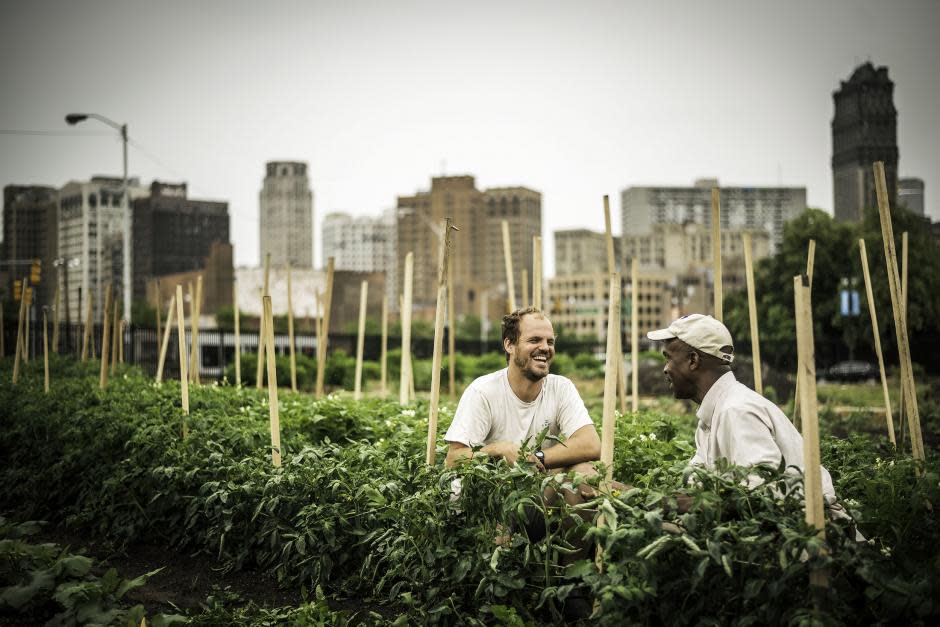
But before it becomes a regular offering at McDonald's, Post’s meat still needs to clear some hurdles. The burger is dry, says Ruetzler; Post’s meat lacks fat, which on a cow-grown burger adds flavor and keeps the meat “juicy.” The growth medium for the ground beef is also a problem: Post’s stem cells have thus far grown successfully into meat only when soaked in a serum made from fetal calf blood—an expensive (and definitely nonvegetarian) option. Post and his colleagues at Maastricht are currently working on solving those problems. Post estimates it’ll be 20 to 30 years before lab-grown beef goes commercial in a big way. In the meantime, though, Amit Gefen, a bioengineer at Tel Aviv University, has already begun experiments in lab-growing chicken. In other words, it’s not totally insane to imagine a near-future in which farmlands become, at least in part, home to high-tech food laboratories.
Gators in the Swimming Pool
If humans can summon the will to bring the full brunt of all this technology and infrastructure to bear on feeding everyone, there will be an interesting side-effect. Up to 20 billion square miles of land previously devoted to food production will be freed up. Where once we ate 40 percent of the Earth’s surface, in the future, ideally, we will eat a bit less than 5 percent. So what do we do with all that extra land?
Despommier tells the story of a Florida farmer whose 30 acres of strawberry fields were destroyed in 1992 by Hurricane Andrew. The farmer got money to rebuild his farm, but instead of replanting strawberries, he used the money to build a greenhouse: “He did this because he thought if he built the greenhouse strong enough it might survive the next hurricane, and he was right,” says Despommier. Moreover, tricked out with hydroponics equipment, the greenhouse was so efficient that 1 acre of indoor space could grow more strawberries than the farmer had previously been able to produce on 30 outdoor acres. This left the farmer with 29 acres of unused land.
The farmer decided to let nature reclaim the former strawberry fields. Soon the crop lands were wetland, “rewilded,” says Despommier. “I talked to him, and he said the only problem he had now was to worry about alligators in his swimming pool.”
Despommier says he wants to be responsible for “rewilding” as much land as possible. The aesthetic and environmental benefits, he says, are desirable enough in and of themselves, but the real kicker is helping stymie or even reverse climate change. If every city could manufacture even 10 percent of what it ate, says Despommier, the subsequent rewilding “would mean a huge addition to hardwood forests that would suck up enough carbon to set the clock back to about 1980 in terms of atmospheric carbon.” And that’s with only about 340,000 square miles of land reclaimed; imagine the climate gains brought by several billion miles of land rewilded—and all with food to spare.
Related Articles

 Yahoo News
Yahoo News 
